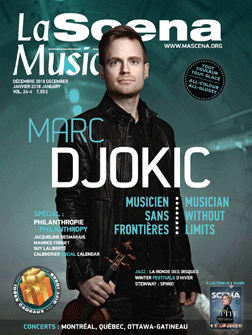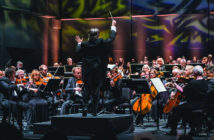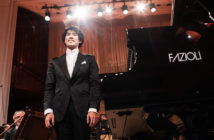
Special symbols on the keyboard, sometimes it’s a little tough,” cellist Joshua Gindele said about the distinctive accent that adorns the name of the Miró Quartet. “But I haven’t seen one missing for a long time.”
Yes, software is better than it was in 1995, when four students at the Oberlin Conservatory in Cleveland rallied around the surname of the Catalan artist Joan Miró to form an ensemble that took first prizes at the 1998 Banff International String Quartet Competition and the 2000 Naumburg Chamber Music Competition.
Now in robust mid-career, the foursome of 40-somethings will appear in Pollack Hall for the Ladies’ Morning Musical Club on Feb. 3 with two sidemen from the disbanded Tokyo String Quartet – Clive Greensmith on cello and Martin Beaver on viola – in a program comprising the two String Sextets of Brahms.
“Their experience helps an enormous amount,” Gindele adds about the guests. “They understand the nuances of colour, balance and tension that maybe a soloist would not have as a strong a grasp on.”
The presence of visitors might also encourage a contrapuntal outlook on these masterpieces, which are naturally plusher than string quartets but rich also in inner voicing.
“If we erase their personalities and make them ‘sit in’ too much, then we’re robbing the audience of the experience of hearing the six of us play,” Gindele says. “We try to create an environment where all six voices can be heard, and strongly.”
Disregarding the switches of their student days, the Mirós have been one of the more stable units on the scene, undergoing only one change since their Banff victory. This was in 2011, when second violin Sandy Yamamoto left the ensemble to take care of her two sons. Her husband, first violin Daniel Ching, remained with the quartet.
“It was a now-or-never kind of thing,” Yamamoto told the Austin Chronicle. “I don’t think I would have this kind of courage to step away ever again.” Not that it was a career-ender: Yamamoto is a professor at the Butler School of Music of the University of Texas at Austin, where the Mirós are quartet in residence.
The vacancy left the Mirós with an interesting dilemma. Should they seek another female player? All-male quartets were common in the middle of the last century but are rare in the 21st.
“There were lots of wonderful players who came to us, women and men,” Gindele recalls.
“We just decided to put together the best group we could – hire the person we thought was the best musically and personally and would bring experience to the group.”
That violinist turned out to be a Canadian, William Fedkenheuer, formerly of the Fry Street Quartet and the Borromeo Quartet, who was active as a fiddler in his youth before settling down to a classical career.
“There was feedback, from concert presenters and audience members and other quartets,” Gindele admits. “They were surprised or disappointed that we didn’t hire a woman to fill Sandy’s chair.
“Sandy brought an influence that was good for us. She created a sensitive environment that was really good for the quartet. We had that discussion. We just had to make the choice that was the best for our musical approach, for how we play.”
The spectacle of six males on the stage of Pollack Hall – the Miró violist is John Largess – is not likely to unsettle the patrons of the Ladies’ Morning Musical Club. Nor has the decision adversely affected the quartet’s progress. The Mirós keep busy not only with engagements but in education through their Austin residency.
Life together has its challenges, which are met partly through respecting family priorities. All the members except Largess have children. In the early days the emphasis was on getting as many gigs as possible. Now more consideration is given to birthdays, anniversaries and holidays.
“We never push anything that’s going to jeopardize anybody’s health or happiness,” Gindele says. “If somebody needs space, we find it.”
The chamber field is more crowded than it once was. The array of recent graduates forming quartets is considerable. Gindele says the Mirós do not feel any heat.
“In our business, concert performers and audiences and seem to think – and they’re right – that the difference between hearing a group that’s been around for 24 years … and one that’s been around for five years, is fairly profound,” he argues.
“Living with the music for a long time really does inform performance. People want to hear the more established groups because of that.”
Despite widespread notions to the contrary, the impact of recording has not completely dissipated. A major label will soon bundle the mostly self-produced Miró Beethoven recordings and issue a complete cycle.
“We’ve been talking to our manager and he really believes that recording is still going to be one of the things that establish groups at the top of the food chain.
“I thought that was interesting. We are always hearing that there are no sales. But the big labels still help careers quite a bit.”
As does a healthy respect for the standard repertoire. While contemporary music is not absent from their dossier – in 2014 the quartet gave the premiere of Gunther Schuller’s String Quartet No. 5 – the players are still happy to play Haydn, Beethoven and Schubert.
“We try to do the things we’re passionate about,” Gindele says. “We’re in a good place right now.”
Miró plays at Pollack Hall for the Ladies’ Morning Musical Club on Feb. 3. For ticket information go to www.lmmc.ca, www.miroquartet.com.















